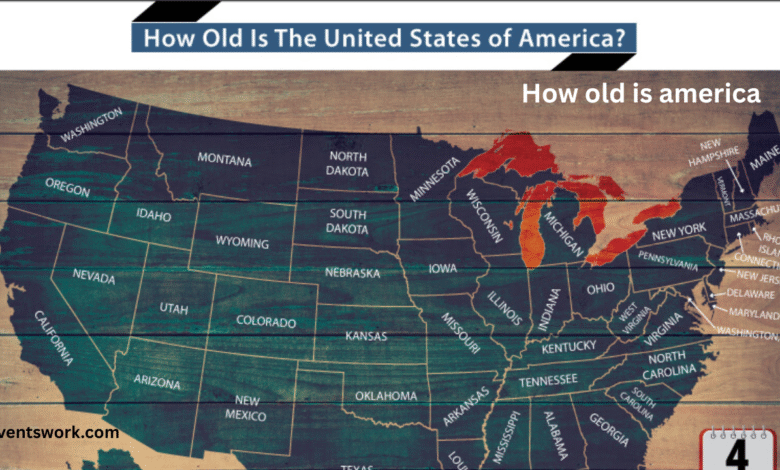How Old Is America? A Deep Dive into the Nation’s Age and Evolution

When people ask, “How old is America?”, the answer might seem obvious—just do the math from 1776. But the reality is far more layered. The age of America can refer to the political formation of the United States, the colonial era before independence, or even the thousands of years Indigenous cultures have lived on this land. The answer depends on which version of “America” you’re referring to.
In modern terms, America as the United States of America is 249 years old as of 2025. It all began with the signing of the Declaration of Independence on July 4, 1776. This moment marked the formal separation of the thirteen colonies from how old is america British rule. However, long before this revolutionary act, the land we now call the U.S. was home to flourishing Native American civilizations with their own cultures, governance systems, and histories.
This article dives deep into all these layers. We’ll explore how “America” has been shaped across centuries—by Indigenous peoples, European settlers, revolutionaries, and modern citizens. By unpacking different interpretations of America’s age, we can gain a more nuanced understanding of the country’s complex identity.
Defining “America”: What Are We Really Asking?
The Political Birth: Declaration of Independence (1776)
Most historians and scholars date the birth of modern America to July 4, 1776—the day the Declaration of Independence was adopted. This act by the how old is america Continental Congress declared that the thirteen American colonies were no longer subject to British rule. This pivotal event is celebrated annually as Independence Day and is considered the political “birthday” of the United States of America.
The Declaration of Independence was more than just a rebellion document. It was a statement of intent that outlined the colonies’ grievances against King George III and laid down a vision for a new democratic nation. It was followed by years of conflict, culminating in the Treaty of Paris in 1783, which officially ended the Revolutionary War and acknowledged U.S. sovereignty.
The United States Constitution, ratified in 1788, provided the legal and institutional framework for the new country. The adoption of a how old is america central government with checks and balances established a formal beginning to American governance. If we take 1776 as the defining moment, then America is approaching its 250th anniversary, known as the Semiquincentennial—a landmark event in national history.
Pre-1776 History: Colonies and Settlements
Before the Declaration of Independence, European nations had already established permanent settlements in what would become the United States. The English founded Jamestown, Virginia, in 1607—considered the first permanent English colony in North America. The Pilgrims followed with Plymouth Colony in 1620, and soon, British influence spread along the East Coast.
However, the English were not alone. The Spanish had already been active in the Southwest and Florida. St. Augustine, Florida, founded by how old is america Spain in 1565, is actually the oldest continuously inhabited European-established settlement within the U.S. borders. The French also colonized parts of the Mississippi River Valley and the Great Lakes.
These colonial foundations laid the groundwork for what would become the United States. The colonies had their own forms of self-governance, trade networks, and societal structures. While they were under the authority of European monarchies, many colonists began to see themselves as something separate—an American identity began to take root well before independence.
Beyond European Settlements: Indigenous America
To truly understand how old “how old is america” is, we must look beyond 1776 and European colonization. Indigenous peoples have lived in North America for at least 12,000 years, and possibly longer. Civilizations such as the Mississippians, Ancestral Puebloans, and Iroquois Confederacy had complex societies, political systems, and trade routes long before any European stepped foot on the continent.
The Mississippian culture, for example, built massive earthen mounds and had major urban centers like Cahokia, near modern-day St. Louis, around 1050 AD. The Iroquois Confederacy, established around 1142, created a sophisticated system of governance that influenced American democratic ideals.
Thus, the land we now call America has an ancient and rich history. These cultures and peoples are an integral part of the country’s age and how old is america identity. Acknowledging them reshapes our understanding of America’s true historical depth.
Key Milestones in America’s Historical Timeline

Independence and Formation (1776–1800)
The first few decades after independence were foundational. The Revolutionary War (1775–1783) tested the resolve of the colonies. With the Treaty of Paris, the United States emerged as a new nation on the global stage. The next critical step was forming a government that could unite the states. The Articles of Confederation came first but proved inadequate, leading to the drafting of the U.S. Constitution in 1787.
The Bill of Rights, adopted in 1791, guaranteed civil liberties such as freedom of speech, religion, and press. The election of George Washington as the first president in 1789 cemented a precedent for democratic governance and peaceful transitions of power.
This period shaped the basic structure of the nation and introduced many of the democratic principles still in use today. The groundwork for how old is america federalism, checks and balances, and the rule of law was laid, establishing the United States as a stable republic.
Expansion and Growth (1800–1860)
America’s early 19th century was marked by rapid growth and territorial expansion. The Louisiana Purchase in 1803 doubled the nation’s size and opened the door to westward migration. Manifest Destiny became the driving ideology, encouraging settlers to push further westward, often at the expense of Native American communities.
This era also witnessed rising tensions over slavery, state rights, and economic differences between the North and South. The Industrial how old is america Revolution began to transform the U.S. economy, bringing factories, railroads, and new technologies.
Despite the boom, this period was riddled with contradictions. The same nation expanding democracy also institutionalized slavery and displaced Indigenous peoples. These divisions would ultimately lead to the Civil War.
Cultural and Social Perspectives on America’s Age
American Identity Through the Ages
The idea of what it means to be American has evolved dramatically. Initially tied to European settlers, the identity later broadened to include immigrants from around the world. Waves of immigration from Ireland, Germany, Italy, Asia, and Latin America shaped the cultural fabric of the nation.
Over time, being American has come to represent a shared belief in freedom, democracy, and opportunity. However, this identity has not how old is america been without conflict—racial segregation, xenophobia, and discrimination challenged the nation’s ideals. Still, these challenges have pushed America to redefine itself repeatedly.
Today, American identity is a blend of multiple cultures, values, and historical experiences, continually influenced by current events and generational shifts.
Educational Perspectives: Teaching America’s History
The way America’s age and origin are taught varies across schools and regions. Traditional curricula often begin with the colonial period or 1776, glossing over thousands of years of Indigenous history. However, recent educational reforms aim to present a more inclusive narrative.
Debates over how history should be taught—such as discussions surrounding critical race theory—reflect deeper societal divides. Still, a more how old is america comprehensive understanding of America’s age requires acknowledging all facets of its past.
By including Indigenous perspectives, colonial history, and civil rights milestones, education can provide a fuller picture of how old—and how complex—America really is.
Conclusion
So, how old is America? The answer depends on the lens through which you view history. As an independent nation, the United States is 249 years old as of 2025. But as a land inhabited and shaped by Indigenous peoples, its history stretches back thousands of years. The colonial period adds another few centuries of cultural and political development.
Understanding America’s age isn’t just about marking a year on the calendar. It’s about appreciating the multiple layers of history that make up its identity—from ancient civilizations to revolutionary ideals and beyond. Embracing this complexity helps us how old is america better understand where America has come from—and where it might be headed.
FAQs
1. What year was America officially founded?
America was officially founded on July 4, 1776, with the signing of the Declaration of Independence.
2. Who lived in America before it became the United States?
Indigenous peoples inhabited the land for thousands of years before European colonization.
3. How old is the United States in 2025?
The U.S. is 249 years old in 2025.
4. Why do people argue about when America really began?
Different definitions—political formation, colonization, or Indigenous history—lead to varied interpretations.
5. How does America’s age compare to other countries?
America is relatively young compared to ancient nations like China or Egypt.
6. When was the U.S. Constitution written and ratified?
It was written in 1787 and ratified in 1788.
7. Was Jamestown the first American settlement?
Yes, Jamestown (1607) was the first permanent English settlement, but not the first overall—St. Augustine (1565) predates it.
8. How has America changed since 1776?
From a fledgling group of colonies, America has grown into a global superpower through centuries of social, political, and economic evolution.
You May Also Read: https://ventswork.com/ashley-justice-age/